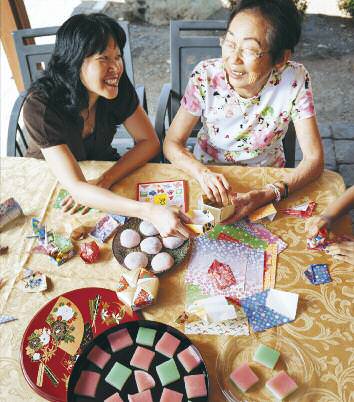cooks at home
THE ART OF FUSION
Cynthia Lu shares her global approach to food and culture.
WRITTEN BY SUE EDMONDSON
PHOTOS BY SHEA EVANS
Thursday nights find Cynthia Lu and 7-year-old daughter Marisa in the kitchen. Tonight they’re mixing sweet rice flour with coconut milk — ingredients for mochi, a triple-layer, baked Japanese dessert. Marisa giggles when a puff of flour balloons up from the bowl and leaves a dusting of white on her chin. After they spread the first layer of batter in a pan and slide it into the oven, they start planning the week’s menu. Meal planning is a family ritual and necessity for this full-time working mom.
That she’s making a Japanese dessert isn’t surprising. Lu, a second-generation Chinese-American is a master of fusion, not necessarily in the sense of melding a variety of ethnic flavors in one dish (although that happens plenty in her kitchen), but in the blending of cultures. Much like mochi, where the three separate layers become a cake, she seamlessly combines traditions to create a unique lifestyle for her family.
“As a child of immigrants, I lived in two different worlds,” Lu says. “There was the world where I went to school and played with friends. At home, it was the world my parents came from. I loved living in both.”
Her former husband and Marisa’s father, Cary Yamamoto, is a native Nevadan/Japanese-American. (Close friends, they’re next-door neighbors). They strive to provide Marisa with every opportunity to experience her heritage, although in a less rigid way than how Lu was raised.
“My mom only cooked Chinese food, and we had to use chopsticks,” she says, laughing. “My sister and I used to beg to eat [fast food]!”
Inside Lu’s home, shoes are exchanged for house slippers, and the rice cooker always is full. At the entrance to his yard, Yamamoto built a welcoming Japanese torii gate. Marisa learns Chinese from Lu’s father, Chung, and Japanese from Yamamoto’s mother, Jane.
Happily for Lu, a foodie whose repertoire includes wiener schnitzel (thanks to her brother-in-law), much of the way Marisa learns about ancestral customs is through food.
“Most traditions center on meals. It’s the natural cultural bond,” she says. “On Christmas Eve, we have my mom’s version of shabu-shabu (a dish comprised of boiled, thinly sliced beef). For Chinese and Japanese New Year’s, we eat dishes that symbolize long life and prosperity.”
Thanksgiving is all American with one exception — she makes the stuffing in a wok.
Home isn’t the only place where Lu blends cultures. She’s a family court master presiding over custody, divorce, and child-protection cases. The judicial position requires an understanding of social, economic, and ethnic differences.
“I believe my family history makes me sensitive to struggles experienced by many of the families that come to court,” she says.
This week’s menu includes homemade sushi. Marisa will use a traditional hand fan to cool the sushi rice, a technique learned from her grandmother.
“Jane has Marisa after school. They spend a lot of time cooking,” Lu says.
The contents aren’t always strictly Japanese — last time she added Chinese mushrooms. Chow mein makes the list, where spaghetti might sub for noodles.
Marisa reminds Lu to add her favorite: “Write down mac and cheese, Mom.”
Freelance writer Sue Edmondson writes for publications in Northern Nevada and Northern California. As a failed experimental cook, she admires successful creativity in cooking.
Tri-Colored Mochi
(courtesy of Cynthia Lu. Serves up to 48)

“Tri-colored mochi is a traditional Japanese dessert made from sweet rice flour called mochiko. Marisa and her friends love to make it. It’s messy, but that’s half the fun,” Lu says.
1 pound mochiko (16-ounce box)
2 cups sugar
1 teaspoon baking powder
1 12-ounce can coconut milk
2 cups water
1 teaspoon vanilla
Food coloring (Lu uses red and green. Buy or make your own natural food coloring, if possible)
Preheat oven to 350 degrees F.
In a large mixing bowl, combine mochiko, sugar, and baking powder. Blend coconut milk, water, and vanilla in a separate bowl. Add to dry ingredients gradually. Thoroughly mix with whisk or spoon. Remove two cups of mixture and add three drops of green coloring. Pour the green batter into greased 9-by-13-inch pan. Cover with foil and bake 15 minutes.
Pour two cups plain batter over cooked layer. Cover with foil and bake 20 minutes.
Add three drops red coloring to remaining mixture and pour over cooked layers. Cover with foil and bake for 30 minutes. Cool uncovered, preferably overnight. Cut into squares when completely cool.


